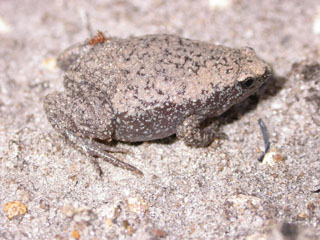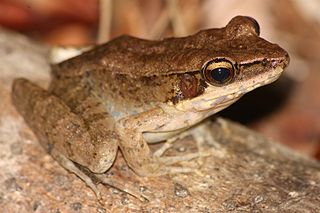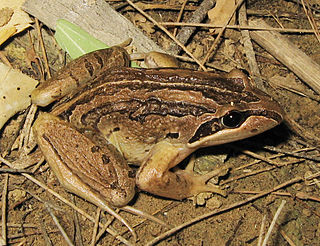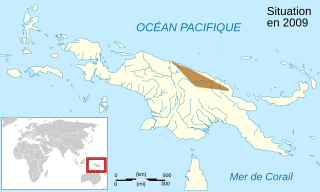
The frogmouths are a group of nocturnal birds related to the nightjars. They are found from the Indian Subcontinent across Southeast Asia to Australia.

The true frogs, family Ranidae, have the widest distribution of any frog family. They are abundant throughout most of the world, occurring on all continents except Antarctica. The true frogs are present in North America, northern South America, Europe, Africa, and Asia. The Asian range extends across the East Indies to New Guinea and a single species has spread into the far north of Australia.

The Microhylidae, commonly known as narrow-mouthed frogs, are a geographically widespread family of frogs. The 584 species are in 61 genera and 11 subfamilies, which is the largest number of genera of any frog family.

Papurana daemeli is a species of "true frog", family Ranidae. It is found in New Guinea, northern Australia, and some smaller islands. It is the only ranid frog found in Australia. In Australia, the species is restricted to the rainforest of northern Queensland and the eastern border of Arnhem Land, in the Northern Territory. In Australia, it is usually known as wood frog or sometimes as water frog. Other vernacular names are Australian wood frog, Australian bullfrog, and Arnhem rana.

Litoria is a genus of Hylidae tree frogs native to Australia, the Bismarck Archipelago, the Solomon Islands, New Guinea, the Lesser Sunda Islands, the Moluccan Islands, and Timor. They are sometimes collectively referred to as Australasian treefrogs. They are distinguishable from other tree frogs by the presence of horizontal irises, no pigmentation of the eyelids, and their Wallacean distribution. About 150 species are described, but several new species are described every year on average, such as the Pinocchio frog, described in 2008 but not yet given a taxonomic name.

The Australian green tree frog, simply green tree frog in Australia, White's tree frog, or dumpy tree frog, is a species of tree frog native to Australia and New Guinea, with introduced populations in the United States and New Zealand, though the latter is believed to have died out. The species belongs to the genus Litoria. It is morphologically similar to some other members of the genus, particularly the magnificent tree frog (L. splendida) and the white-lipped tree frog (L. infrafrenata).

The barred frogs are a group of frogs in the genus Mixophyes. They are the largest of the Australian ground frogs, from the family Myobatrachidae.

Limnodynastes is a genus of frog native to Australia, southern New Guinea and some Torres Strait Islands. They are ground-dwelling frogs, with no toe pads. The size varies from 45 mm to 90 mm in the giant banjo frog. The webbing on the feet ranges between species, from very little, to almost complete. The tympanum is not visible in any species, except in the woodworker frog, which is sometimes classed in a separate genus Megistolotis. All species construct a foam nest in which the eggs are laid. However, in south-eastern South Australia female striped marsh frog and spotted grass frog lack the flanges of skin on the hands that helps trap the air bubble and do not construct foam nests.

The Lechriodus is a genus of ground-dwelling from the family Myobatrachidae, native to eastern Australia and New Guinea. They are medium-sized frogs and the dorsal skin has a sandpaper-like texture. They are unique amongst myobatrachids genera in that there is more species that occur on New Guinea than in Australia.

The Myobatrachidae are a family of frogs found in Australia and New Guinea. Members of this family vary greatly in size, from species less than 1.5 cm (0.59 in) long, to the second-largest frog in Australia, the giant barred frog, at 12 cm (4.7 in) in length. The entire family is either terrestrial or aquatic frogs, with no arboreal species.

The fauna of New Guinea comprises a large number of species of mammals, reptiles, birds, fish, invertebrates and amphibians.
Choerophryne darlingtoni is a species of frog in the family Microhylidae. It is endemic to Papua New Guinea and found in the New Guinea Highlands. The specific name darlingtoni honors P. Jackson Darlington, Jr., an American evolutionary biologist and zoogeographer. Common name Darlington's rainforest frog has been coined for it.

Copiula tyleri is a species of frog in the family Microhylidae. It is endemic to northeastern New Guinea and is found in both Western New Guinea and Papua New Guinea. The specific name tyleri honours Michael J. Tyler, Australian herpetologist who have worked extensively with Australian and New Guinean frogs.
Cornufer cheesmanae is a species of frog in the family Ceratobatrachidae. It is endemic to New Guinea and found in the Cyclops Mountains and Bewani Mountains. The specific name cheesmanae honors Lucy Evelyn Cheesman, an English entomologist, explorer, and curator at London Zoo. Common name Cheesman's wrinkled ground frog has been coined for it.

The forest kingfisher, also known as the Macleay's or blue kingfisher, is a species of kingfisher in the subfamily Halcyoninae, also known as tree kingfishers. It is a predominantly blue and white bird. It is found in Indonesia, New Guinea and coastal eastern and Northern Australia and Singapore. Like many other kingfishers, it hunts invertebrates and small frogs and lizards.

The little shrikethrush is a species of bird in the family Pachycephalidae.
Richard George Zweifel is an American herpetologist, who has classified several species in the American Southwest and in Australia, including the rattling frog. Zweifel worked at the American Museum of Natural History from 1954 to 1989, and was Herpetology Department Chairman from 1968 to 1980.

Papurana papua is a species of true frog, family Ranidae. It is endemic to New Guinea and found in the northern part of the island in both Indonesia and Papua New Guinea as well in some offshore islands. Common name Papua frog has been coined for it.
The brown frog (Rana) is a genus of about 50 species of true frogs found through much of Eurasia, North America, Africa, Central America, and the northern half of South America.














